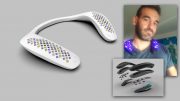By Matt O’Donovan, CEO, WiFi SPARK
It’s no secret that within hospitals today, new technology is making the impossible, possible. You can walk into a hospital and what you will see will be reminiscent of a science fiction film – new innovations being used to help fight diseases. But in these very same hospitals you will also see innovations that are stuck in a technological time vacuum.
It is high on the hospital agenda to take advantage of new technology that helps administer patient care, and there is no doubt that technology will continue to play an increasingly important role for years to come. But the technology that patients’ interact with within the hospital environment is not evolving at the same pace. For patients, technology that improves their experience is not given the same urgency.
Ultimately, the primary role of a hospital is to provide the very best patient care – and hospitals are investing in technology that helps them do this. But hospitals are also aware that they need to do more to enhance the experience – after all, experience has an impact on patient wellbeing.
As patient expectations rise, how can hospitals take advantage of technology that brings the experience into the 21st century, but doesn’t take away from the foundation of which hospitals are built – on providing care?
Going beyond care
The view that hospitals should be solely focused on providing medical care is one that is dominant, and rightfully so. After all, a hospital’s main job is to heal those who are ill. Hospitals are turning to technology to support this – in fact, there is talk intensifying around 3D printers emerging as a medical technology, able to regenerate skin cells and even ‘print’ blood vessels and synthetic ovaries.
But you can also walk around a hospital and see technology that is over a decade old – or a complete lack of technology all together. Hospitals are one of the biggest users of pagers, and there is an estimated 9,000 fax machines in use within NHS hospitals today. The majority of hospitals also take patients food orders with ‘good old fashioned’ pen and paper, and patients watch television on cumbersome screens which hang over their beds.
Healthcare professionals are beginning to take a more holistic view of the hospital experience. This change in attitude is evident in the NHS’s Test Bed scheme, with trusts implementing innovative technologies to improve the patient experience. The scheme is seeing patients given access to their digital health records, manage and schedule appointments, given visibility of their waiting times, as well as the remote reporting of their health status. Not only has this allowed patients to plan their hospital visits in a much superior way, these innovations are also predicted to reduce the number of missed appointments.
Taking inspiration from apps
When we consider the patient experience, we need to consider how wide and encompassing this is. The patient experience starts the moment a patient enters a hospital grounds, and encompasses almost everything until the moment they leave – from parking to food, comfort, right through to connectivity, entertainment and communications services. With the patient experience a combination of a number of different factors, it has been troublesome to employ cost effective technology that can be installed across the entire patient ecosystem that doesn’t impact the day-to day running of the hospital.
Yet outside of a hospital, consumers are able to take advantage of technology that manages the many different aspects of their day-to day lives – from apps that wake them up in the morning, to apps that allow them to manage their finances, check train times, board flights, and ensure their homes are secure. But while it is a smartphone that is the vehicle for this, it isn’t the smartphone itself that enables consumers to do all of these things – it is the app ecosystem that is the key. The app store provides a platform that allows consumers to manage their lives, all through a click of a button (or a swipe of a screen).
And it is this model that hospitals need to take inspiration from to bring the patient experience in line with expectations. This would allow patients to use their own devices to access TV, media and communications services, eliminating the need for the old, outdated TVs (and charges) that we see in hospitals today – and also allow them to interact with content in a way that they are accustomed to today. Applications that allow patients to order their own meals with set dietary requirements gives them control over the food ordering process, removes reliance on hardworking NHS staff, reduces food waste and allows the nurses to dedicate more time to their vital work.
And just as we have apps for every element of our lives, the same model can be applied to every aspect of the patient experience – digital solutions that allow patients to check in and out of hospital, technology that allows you to pay for car park fees, check the status of A&E waiting times – to applications of the future that are beyond our imagination.
Closing the technology gap
It is clear that technology is playing, and will continue to play, an important role within hospitals. It is being used today to deliver care that is changing lives, and will continue to help provide care as technology continues to advance and develop.
But technology isn’t playing the same role in shaping the patient experience. As more and more hospitals shift their focus to providing a holistic service to patients, they should take inspiration from the technology we hold in our pockets. Instead of trying to re-invent the wheel, hospitals should look at the technology that is already transforming patients’ lives outside the hospital walls.
Implementing simple technological changes in hospitals will transform the patient experience for the better, and bring the overall standard of technology in hospitals back to the future.





